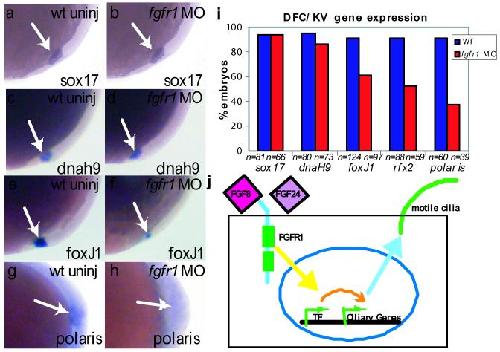XB-IMG-123892
Xenbase Image ID: 123892

|
|
Figure 4. FGF signaling controls ciliogenic genes in DFC/KV cells(a, b) sox17 expression in DFC/KV (and endoderm cells in a different focal plane) in 90% epiboly embryos was normal in fgfr1 morphants and WT embryos. (c, d) Expression of dnah9 in 95 % epiboly embryos was normal in fgfr1 morphants and WT embryos. (e, f) In contrast, foxJ1 was down-regulated in fgfr1 morphants versus WT embryos at 90% epiboly. (g, h) Similarly, polaris was down-regulated in fgfr1 morphants versus WT embryos at tailbud stage. (i) Comparison of percentage of embryos with WT expression levels of each gene indicated. (j) Proposed mechanism by which FGF signaling controls length of motile cilia: FGF ligands bind to FGFR1 activating downstream transcription factors (TF) including foxj1 and rfx2, these TF activate IFT genes (e.g. polaris) to maintain motile cilia length on epithelial cells. Image published in: Neugebauer JM et al. (2009) Image downloaded from an Open Access article in PubMed Central. Image reproduced on Xenbase with permission of the publisher and the copyright holder. Larger Image Printer Friendly View |
